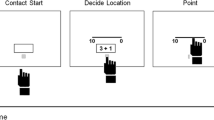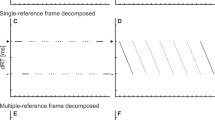Abstract
In a parity-judgment task smaller numbers are responded to faster with the left-hand key and vice versa for larger numbers (SNARC effect; Dehaene et al., in Journal of Experimental Psychology: General, 122, 371–396, 1993). We used the psychological refractory period paradigm involving a parity-judgment task and tone-discrimination task to address the question at which stage this effect arises. When the parity-judgment task is performed second, then we found equal SNARC effects for the short and the long SOA. According to the central bottleneck model, this indicates that the effect arises during the response-selection or execution stage. In Experiment 2 the parity-judgment task was performed first. The pattern of results indicates that the SNARC effect originates during the perceptual encoding or response-selection. Together, our results suggest that the SNARC effect originates while the response is selected.







Similar content being viewed by others
Notes
These words were used to ensure similar voice onset latencies for both responses
We also conducted the experiment with six participants and manually recorded their vocal responses. The pattern of results (for both the tone-discrimination task and the parity-judgment task) obtained were the same as those reported below in which the vocal errors were included. Moreover, the vocal error rate was very low (1.35%). We conclude that the vocal error rates do not influence the main pattern of our findings
We used a short SOA of 150 ms (in contrast to 50 ms in Experiment 1) as pre-experiments had indicated that a SOA of 50 ms made it very difficult for participants to discriminate which stimulus was presented first.
The t value and SE refer to transformed error rates.
References
Bishop, Y. M. M., Fienberg, S. E., & Holland, P. W. (1975). Discrete multivariate analysis. Cambridge: MIT Press.
Brannon, E. M. (2005). What animals know about numbers. In: J. I. D. Campbell (Ed.), Handbook of mathematical cognition (pp. 85–107). New York: Psychology Press.
Caessens, B., Hommel, B., Reynvoet, B., & van der Goten, K. (2004). Backward-compatibility effects with irrelevant stimulus-response overlap: The case of the SNARC effect. Journal of General Psychology, 13, 411–425.
Campbell, J. I. D. (Ed.). (2005). Handbook of mathematical cognition. New York: Psychology Press.
De Jong, R. (1993). Multiple bottlenecks in overlapping task performance. Journal of Experimental Psychology: Human Perception and Performance, 19, 965–980.
Dehaene, S. (1996). The organization of brain activations in number comparison: Event-related potential and the additive-factors method. Journal of Cognitive Neuroscience, 8, 47–68.
Dehaene, S. (1997). The number sense. How the mind creates mathematics. New York: Oxford University Press.
Dehaene, S., Bossini, S., & Giraux, P. (1993). The mental representation of parity and number magnitude. Journal of Experimental Psychology: General, 122, 371–396.
Dehaene, S., Molko, N., Cohen, L., & Wilson, A. J. (2004). Arithmetic and the brain. Current Opinion in Neurobiology, 14, 218–224.
Fias, W. (2001). Two routes for the processing of verbal numbers: Evidence from the SNARC effect. Psychological Research, 65, 250–259.
Fias, W., & Fischer, M. H. (2005). Spatial representation of numbers. In: J. I. D. Campbell (Ed.), Handbook of mathematical cognition (pp. 43–54). New York: Psychology Press.
Fias, W., Brysbaert, M., Geypens, F., & d’Ydewalle, G. (1996). The importance of magnitude information in numerical processing: Evidence from the SNARC-effect. Mathematical Cognition, 2, 95–110.
Fias, W., Lauwereyns, J., & Lammertyn, J. (2001). Irrelevant digits affect feature-based attention depending on the overlap of neural circuits. Cognitive Brain Research, 12, 415–423.
Fischer, M. H. (2003). Spatial representation in number processing—evidence from a pointing task. Visual Cognition, 10, 493–508.
Fischer, M. H., Castel, A. D., Dodd, M. D., & Pratt, J. (2003). Perceiving numbers causes spatial shifts of attention. Nature Neuroscience, 6, 555–556.
Fischer, M. H., Warlop, N., Hill, R. L., & Fias, W. (2004). Oculomotor bias induced by number perception. Experimental Psychology, 51, 91–97.
Gallistel, C. R., & Gelman, R. (2000). Non-verbal numerical cognition: From reals to integers. Trends in Cognitive Neuroscience, 4, 59–65.
Gevers, W., Reynvoet, B., & Fias, W. (2003). The mental representation of ordinal sequences is spatially organized. Cognition, 87, B87–B95.
Gevers, W., Ratinckx, E., De Baene, W., & Fias, W. (2006). Further evidence that the SNARC effect is processed along a dual-route architecture: Evidence from the lateralized readiness potential. Experimental Psychology, 53, 58–68.
Hubbard, E. M., Piazza, M., Pinel, P., & Dehaene, S. (2005). Interactions between number and space in parietal cortex. Nature Reviews Neuroscience, 6, 435–448.
Keus, I. M., & Schwarz, W. (2005). Searching for the functional locus of the SNARC effect: Evidence for a response-related origin. Memory & Cognition, 33, 681–695.
Keus, I. M., Jenks, K. M., & Schwarz, W. (2005). Psychophysiological evidence that the SNARC effect has its functional locus in a response selection stage. Cognitive Brain Research, 24, 48–56.
Lorch, R. F., Jr., & Meyers, J. L. (1990). Regression analyses of repeated measures data in cognition research. Journal of Experimental Psychology: Learning, Memory, and Cognition, 16, 149–157.
Mapelli, D., Rusconi, E., & Umiltà, C. (2003). The SNARC effect: An instance of the Simon effect? Cognition, 88, B1–B10.
McCann, R. S., & Johnston, J. C. (1992). Locus of the single-channel bottleneck in dual-task interference. Journal of Experimental Psychology: Human Perception and Performance, 18, 471–484.
McCann, R. S., Remington, R. W., & Van Selst, M. (2000). A dual-task investigation of automaticity in visual word processing. Journal of Experimental Psychology: Human Perception and Performance, 26, 1352–1370.
Miller, J., & Reynolds, A. (2003). The locus of redundant-targets and nontargets effects: Evidence from the Psychological Refractory Period paradigm. Journal of Experimental Psychology: Human Perception and Performance, 29, 1126–1142.
Moyer, R. S., & Landauer, T. K. (1967). Time required for judgments of numerical inequality. Nature, 215, 1519–1520.
Nuerk, H.-C., Iversen, W., & Willmes, K. (2004). Notational modulation of the SNARC effect and the MARC (linguistic markedness of response codes) effect. The Quarterly Journal of Experimental Psychology, 57A, 835–863.
Nuerk, H.-C., Wood, G., & Willmes, K. (2005). The universal SNARC effect. The association between number magnitude and space is amodal. Experimental Psychology, 52, 187–194.
Oriet, C., Tombu, M., & Jolicœur, P. (2005). Symbolic distance affects two processing loci in the number comparison task. Memory & Cognition, 33, 913–926.
Otten, L. J., Sudevan, P., Logan, G. D., & Coles, M. G. H. (1996). Magnitude versus parity in numerical judgments: Event-related brain potentials implicate response conflict as the source of interference. Acta Psychologica, 94, 21–40.
Pashler, H. (1984). Processing stages in overlapping tasks: Evidence for a central bottleneck. Journal of Experimental Psychology: Human Perception and Performance, 10, 358–377.
Pashler, H. (1993a). Doing two things at the same time. American Scientist, 81, 48–55.
Pashler, H. (1993b). Dual-task interference and elementary mental mechanisms. In D. Meyer & S. Kornblum (Eds.), Attention and performance XIV (pp. 245–264). Cambridge, MA: The MIT Press.
Pashler, H. (1994). Dual task interference in simple tasks: Eata and theory. Psychological Bulletin, 116, 220–244.
Pashler, H. (1998). The psychology of attention. London: The MIT Press.
Pashler, H., & Johnston, J. C. (1998). Attentional limitations in dual-task performance. In: H. Pashler (Ed.), Attention (pp.155–189). Hove: Psychology Press.
Pinel, P., Dehaene, S., Rivière, D., & LeBihan, D. (2001). Modulation of parietal activation by semantic distance in a number comparison task. NeuroImage, 14, 1013–1026.
Restle, F. (1970). Speed of adding and comparing numbers. Journal of Experimental Psychology, 83, 274–278.
Schwarz, W., & Ischebeck, A. (2001). On the interpretation of response time vs. onset asynchrony functions: Application to dual-task and precue-utilization paradigms. Journal of Mathematical Psychology, 45, 452–479.
Schwarz, W., & Ischebeck, A. (2003). On the relative-speed account of number-size interference effects in comparative judgments of numerals. Journal of Experimental Psychology: Human Perception and Performance, 29, 507–522.
Schwarz, W., & Keus, I. M. (2004). Moving along the mental number line: Comparing SNARC effects with saccadic and manual response. Perception & Psychophysics, 66, 651–664.
Schwarz, W. & Müller, D. (2006). Spatial associations in number-related tasks: A comparison of manual and pedal responses. Experimental Psychology, 53, 4–15.
Schweickert, R. (1978). A critical path generalization of the additive factor method: Analysis of a Stroop task. Journal of Mathematical Psychology, 18, 105–139.
Sigman, M., & Dehaene, S. (2005). Parsing a cognitive task: A characterization of the Mind’s bottleneck. PLoS Biology, 3, e37.
Smith, M. C. (1969). The effect of varying information on the psychological refractory period. Acta Psychologica, 30, 220–231.
Sternberg, S. (1969). The discovery of processing stages: Extensions of Donders’ method. In: W. G. Kloster (Ed.), Attention and performance II (pp. 276–315). Amsterdam: North Holland.
Telford, C. W. (1931). The refractory phase of voluntary and associative responses. Journal of Experimental Psychology, 14, 1–36.
Tlauka, M. (2002). The processing of numbers in choice-reaction tasks. Australian Journal of Psychology, 54, 94–98.
Tombu, M., & Jolicœr, P. (2003). A central capacity sharing model of dual-task performance. Journal of Experimental Psychology: Human Perception and Performance, 29, 3–18.
Tombu, M., & Jolicœr, P. (2005). Testing the predictions of the central capacity sharing model. Journal of Experimental Psychology: Human Perception and Performance, 31, 790–820.
Zorzi, M., Priftis, K., & Umiltà, C. (2002). Neglect disrupts the mental number line. Nature, 417, 138–139.
Author information
Authors and Affiliations
Corresponding author
Rights and permissions
About this article
Cite this article
Müller, D., Schwarz, W. Exploring the mental number line: evidence from a dual-task paradigm. Psychological Research 71, 598–613 (2007). https://doi.org/10.1007/s00426-006-0070-6
Received:
Accepted:
Published:
Issue Date:
DOI: https://doi.org/10.1007/s00426-006-0070-6




